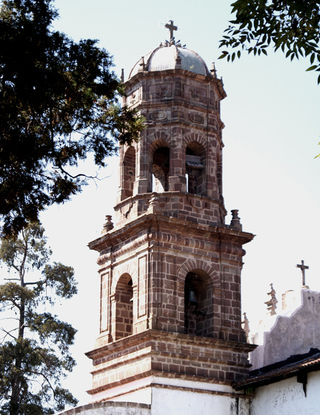
The belltower of the Templo de Nuestra Señora de La Soledad (Our Lady of Solitude, the "new" church, built in the late 18th-early 19th Century), is visible from almost anywhere in Tzintzuntzan. Typical crafts from Tzintzuntzan and other nearby towns are available in the marketplace just outside the churchyard.
Mexico Cooks! often travels the forty minutes from Morelia to Tzintzuntzan, Michoacán, to visit friends. At one time the seat of the Purhépecha kingdom, the town is still rich in the fascination of ancient tradition and its modern interpretation. Tzintzuntzan, which translates from the Purhépecha language to 'the place of the hummingbird', attracts a new kind of hummingbird these days: the tourist. Arriving singly or in groups, the tourist dips into Tzintzuntzan for shopping, just as the hummingbird sips a flower, and just as quickly flits away.
Best known for its Purhépecha Noche de Muertos (Night of the Dead) celebrations, Tzintzuntzan is also an artisans' center. Clay pots, adornos de popote (straw decorations), wood, and hand-embroidered textiles fill the marketplace and shops.
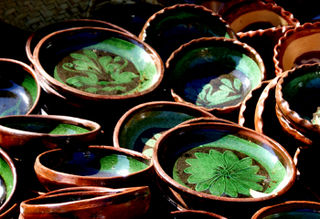
Pottery decorated with green flora and fauna on a black background is indigenous to Tzintzuntzan.
Tzintzuntzan is one of many Michoacán towns sustaining a living tradition: alfarería (pottery making). Clay is abundant in the Michoacán hills and many Purhépecha dedicate their lives to creating both utilitarian and artistic pots. Tzintzuntzan's traditional glaze colors and designs are unmistakable.

About 50 years ago, Miguel Morales popularized Tinztzuntzan's vajilla (dish sets) glazed in white and dark brown. Designs on these two bowls include ordinary local sights: the burro carries firewood, the fish are from Lake Pátzcuaro.

Mexico Cooks! grows rosemary, mint and geraniums in these Tzintzuntzan macetas tradicionales (traditional flower pots). China (CHEE-nah) decided she'd get in the picture.
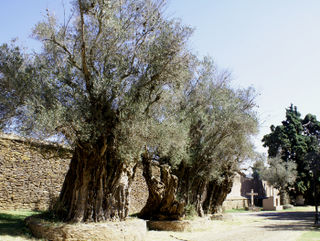
These and many other olive trees, planted by Bishop Vasco de Quiroga
soon after the Spanish arrived in Michoacán, continue to flourish In
the huge atrium of Tzintzuntzan's Ex-Convento de San Francisco (Former
Monastery of St. Francis).
Three churches anchor the west side of the atrium: the oldest is the Capilla Abierta de la Concepción
(Open Chapel of the Conception), built in the early 16th Century.
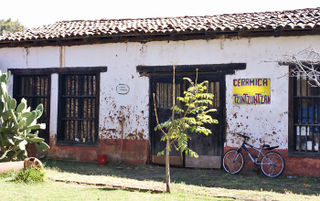
Cerámica Tzintzuntzan nestles in the farthest corner of the church atrium. If the bicycle is leaning on the front of the taller (workshop) and the padlock is missing from the hasp on the door, the workshop is open and you might find Manuel Morales at his potter's wheel.
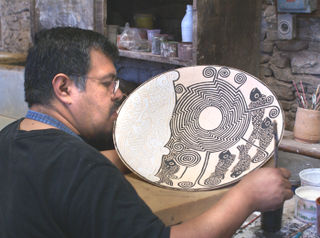
Luis Manuel Morales Gámez, Tzintzuntzan native, artist, and master potter, has created high-fired ceramics for 25 years. His family has worked clay for five generations. Manuel Morales and his father, Miguel, a traditional potter who switched from wood-fired kilns to high-fired ovens, worked together until his father died in an accident.
In 1982, Manuel Morales'
father, Sr. Miguel Morales, received a government subsidy which made it possible to purchase an
electric-powered wheel and the only gas-fired kiln in the village. Under his father's tutelage, Manuel began to
work in clay at the age of eight. Later
Manuel studied painting and graphic design at the University of Michoacán in Morelia,
where he was influenced by the great Mexican painters Diego Rivera, David Siqueiros, José Clemente Orozco, Rodolfo Tamayo, and Pablo Picasso. He
studied the ancient cultures of South America and Mexico, and in particular his own Purhépecha culture, incorporating into his own work ancient symbols found on the yácatas (pyramids) just outside the village.
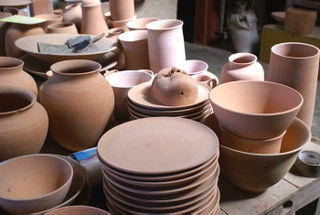
Green ware ready to be glazed.
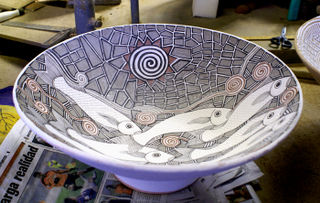
This large vessel, similar in shape and size to the one Manuel Morales is holding in the photo above, is ready to be fired.
Manuel returned to
Tzintzuntzan and began to create pottery which reflects
his own world view, a view which integrates past and present and expresses the
vitality, soul and spirit of his village.
His greatest inspiration comes from the natural world, in particular the
lake where since childhood he has watched the unchanging rituals of fishermen
as they set sail at dawn or under the full moon, in expectation of their return
with a full catch.

Finished pots ready for sale. Each of Morales' pieces is unique and the ochre, black, and deep blue colors are particular to his work.
There are few Mexican potters who have achieved the level of accomplishment that Morales enjoys. His work, sold in a very few exclusive Mexican shops, is often shipped to Europe and the United States for sale. The pots Morales sells at Cerámica Tzintzuntzan are occasionally seconds, pieces with tiny defects that are all but invisible.
"Making pottery always has a component of risk," Morales mused when Mexico Cooks! visited him last month. "After three months of painting bowls, platters, vases, and other pieces, I have enough work to fire. Once the pots are in the kiln, all you can do is pray. Sometimes the pieces that have required the most work before firing come out with a crack, or the glaze runs, or some other surprise happens that makes the pieces useless. When clients place special orders, I always tell them that we won't know the results until the firing is done and I open the kiln. Of course we hope for the best, but we never know."
Some of his best pots have regularly won top prizes at Mexican competitions. So much of his current work is made to special order that he now has little time to make pots destined solely for competition.

Manuel Morales' signature on the small bowl (middle front) in the photo above.
In addition to the Cerámica Tzintzuntzan pottery available at Morales' workshop in the church atrium, pots are usually available at the Casa de Artesanía in Morelia, at a few select shops in Pátzcuaro, and at Colección Herlinda Palacios, Independencia #227 in Tlaquepaque, Jalisco.
Manuel Morales is the fifth generation of his family to fire pots in Tzintzuntzan. The legacy continues, however, with his son and his three young daughters. Born and raised in Tzintzuntzan, they have clay in their blood and are already making pottery.
Looking for a tailored-to-your-interests specialized tour in Mexico? Click here: Tours.
Leave a Reply to Paul Roberts Cancel reply